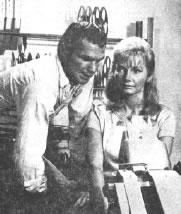In 1967, Moab was
Focused on both Filming and Fun
by Jeff Richards
Some 37 years ago, in
the summer of 1967, the town of Moab was abuzz with the
filming of two simultaneous productions from Paramount Pictures.
Of course, the scenic wonders of the Moab area had already
been gracing movie screens for two decades, beginning with
John Ford’s “Wagon Master” in 1949. In
the interim, nearly two dozen other major Westerns had also
been staged in the area.
But the 1967 dual production was seen as a fairly major
coup for the local chamber of commerce’s film committee.
Committee chairman Norman Boyd reportedly wooed the studio
long and hard to shoot the two films in Moab. “You
have to let (the studios) know you want them,” Boyd
was quoted as saying in the Aug. 3, 1967 issue of Moab’s
weekly newspaper, The Times-Independent.
The two films made in Moab that summer were “Fade-In”
(1968) and “Blue” (1968). Although neither film
was either particularly memorable or successful, both are
currently available on video.

Burt Reynolds and Barbara Loden
|
“Fade-In,”
in fact, was never released in American theaters, although
it was later shown on television. Released on video under
its alternate title “Iron Cowboy,” it is a romantic
comedy starring Burt Reynolds and Barbara Loden. Loden portrays
a Hollywood film worker who comes to Moab with a film production
company and falls in love with a local rancher (Reynolds).
It was apparently the first made-in-Moab Hollywood film
to feature the businesses and buildings in town as the on-screen
setting (as opposed to the usual red rock countryside).
Scenes were shot with Reynolds and Loden attending a movie
at the old Holiday Theater (where the Wells Fargo Bank parking
lot is now), bowling at the old Moab Lanes (currently the
ALCO store), and having their car serviced at the American
Oil gas station at the corner of Main and Center (currently
the site of the Moab Information Center).
The finished film, however, was apparently a disappointment,
and director Jud Taylor even removed his own name from the
credits. The pseudonym Alan Smithee, traditionally applied
to Hollywood’s stinkers, was used instead.
“Blue,” the other film made in Moab that summer,
fared slightly better than “Fade-In,” at least
making it to theaters. The title “Blue” comes
from Terence Stamp’s character, a blue-eyed desperado
named Azul (Spanish for “blue”), the adopted
son of a Mexican bandito played by Ricardo Montalban.
The film follows Montalban’s character and his sons
crossing the Rio Grande River into the United States and
raiding a small settlement. However, Azul has a change of
heart, and decides he wants to stay in the U.S. He ends
up saving and falling in love with Joanna Pettet’s
character, and ends up being nursed back to health by her
father (a doctor played by Karl Malden) as the rest of the
gang heads back to Mexico.
“The movie filming activities have turned out to be
one of the biggest tourist attractions in the area,”
the Times-Independent noted. “Autograph hounds are
active when the stars come in each evening. Restaurants
are all experiencing thriving business.” The newspaper
also reported that the film’s cast had participated
in a friendly softball game against locals, and Moabite
Ed Neal was pictured going up the grip of a bat with Montalban
to see who got to be the lead-off batter.
The “Blue” cast and crew numbered about 125,
and another 65 worked on “Fade-In.” An estimated
300 local Moabites worked on either or both film crews,
including many students home for the summer who worked as
extras or horse riders.
The Aug. 3, 1967 edition of the T-I featured two special
eight-page supplemental sections, one dealing with the film
productions themselves, and another touting the area’s
recreational attractions. “Welcome to Moab: A Vacation
Paradise” read the banner headline of the area scenic
supplement.
“Moab’s great variety of things to do and places
to see, is a drawing card, to say nothing of the modern,
up-to-date facilities in town,” boasted one photo
caption.
Various attractions were also touted, including the numerous
Jeep trails available for exploration via four-wheel drive
vehicle or motorbike (Moab’s now-famous Jeep Safari
had been instituted that spring by the local chamber of
commerce). Canyonlands National Park, then only three years
old, was also hyped, and a large advertisement invited visitors
to “see the nation’s newest national park in
all its original unspoiled scenic splendor with Mitch Williams
Tag-a-Long Tours.”
Visitors were also invited to explore the La Sals by hiking
Mt. Peale, to sightsee in Arches National Monument (now
a national park), and explore the Colorado River with such
tours as “Canyonlands by Night.”
Although the 10-cent newspaper’s pages are yellowed
with age, they provide an interesting snapshot of what Moab
was like in 1967, as it struggled to carve a new niche for
itself after the uranium boom petered out. Hollywood, of
course, still continues to make movies here (“Thelma
and Louise,” “Mission Impossible 2”),
and many of the attractions touted then are still as popular
as ever, if not more so. This month, for example, marks
the 38th annual Easter Jeep Safari. Those various newspaper
stories from a not-so-bygone era remind one that although
times have certainly changed in the Moab area over the past
36 years, many things have stayed remarkably the same.

